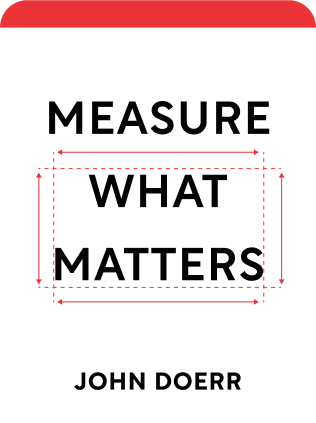

This article is an excerpt from the Shortform summary of "Measure What Matters" by John Doerr. Shortform has the world's best summaries of books you should be reading.
Like this article? Sign up for a free trial here .
What are the benefits of OKRs? Can OKRs help your business succeed? How can they help your company?
The benefits of OKRs are many. In addition to setting clear and measurable goals, there are many additional benefits of OKRs. Using OKRs creates transparency, and can help you build aa positive company culture.
Read more about the benefits of OKRs below.
Why Use OKRs?
Is your company focused on the right things? Do you really understand what goals will move your company forward, and how to measure them? OKRs can help. In Measure What Matters, venture capitalist John Doerr shows you how to use the OKR management system to identify your priorities, set ambitious goals, clearly measure and track them, and motivate and align everyone on your team.
This is the system that helped Larry Page and Sergey Brin turn a small startup called Google into one of the most ambitious and innovative companies in the world. Whether your business is large or small, OKRs are invaluable tools. Learn to implement the same management system used by Google, Intel, LinkedIn, Disney, Twitter, and Spotify.
The Benefits of Transparency
In order for everyone’s goals to be aligned and contributing to the same ultimate objective, everyone’s goals, and their progress toward those goals, need to be transparent. The OKR system builds this necessary transparency into the process. CEOs can look at the goals of their executives, managers, and junior staff, and junior staff can (and should) look at the goals of their bosses and the CEO—everything is public.
Aside from alignment, there are other benefits of okrs and transparency:
Benefit #1: Transparency Increases Productivity and Engagement
Studies show that you’re more likely to achieve goals that you’ve made public, and OKRs are always public. Similarly, 92% of employees are more motivated to reach their goals at work if their progress is made visible to their colleagues, as it is in the OKR system.
Benefit #2: Transparency Fosters Collaboration
If your colleagues know your goals, and they know how much (or how little) progress you’ve made toward them, they have a better sense of how and when to help. This fosters support among peers and strengthens workplace morale.
Additionally, your goals might be similar to a colleague’s, and, consequently, you might have resources, strategies, or information that could help your colleague reach her goals. You can’t know which of your resources could be useful to your peers if you don’t know what they’re working on.
Benefit #3: Transparency Reduces the Risk of Redundant, Overlapping Goals
In large companies, people often work on the same thing, and toward the same goal, without realizing it. Making sure everyone knows everyone else’s goals helps keep employees from performing redundant tasks and, consequently, saves the company time and money.
The Side Benefits of OKRs and CFRs
We’ve discussed the explicit benefits of OKRs and CFRs, but there are also benefits of OKRs that are more implicit. You gain these OKR benefits just by working through the OKR/CFR process, irrespective of the process’s outcomes.
Side Benefit #1: OKRs Force Executives to Set Realistic Goals
When Zume co-founder Alex Garden worked as a general manager for Microsoft’s Xbox Live, he found that the objectives set by executives were often unrealistic or impractical because these leaders weren’t in touch with the day-to-day operations of the company.
Conversely, executives who use OKRs have to figure out what key results will lead to their objectives. They need to know the how, as well as the what. OKRs and CFRs provide leaders with a reality check.
Side Benefit #2: OKRs Teach Future Managers How to Be Leaders
Garden says that when you’re an employee, you’re often evaluated based on the volume of your contributions to the company. If you produce a lot, you’re promoted, and eventually, you find yourself in a manager position. Now, instead of being evaluated by the quantity of your work, you’re evaluated by the quality of your decisions. You’re paid to think, rather than do.
However, no one tells you that as a manager, working smarter matters more than working harder. Furthermore, no one tells you how to work smarter. Consequently, when problems arise, you just keep working harder and harder, because that’s what you’ve always done and that’s what’s worked in the past.
One major benefit of the OKR system is that it forces everyone, at every level of the company, to work smarter:
1) It forces everyone to align their goals with the company’s goals, and to understand exactly how their specific goals and activities contribute to the company’s success. In other words, it forces every employee to think like a manager.
2) It forces people to be specific about their priorities—you can only choose three to five goals, and you need to know exactly how you’ll achieve them and how you’ll measure their success. Again, employees learn to think like managers. Then, as a manager, she already knows how to make quality decisions and lead others to do the same.
3) It forces all employees to take ownership of their ideas and goals and to have a voice. In some organizations, only the loudest members are heard. In OKR organizations, everyone’s voice is heard because everyone’s goals are transparent. Everyone has to take on the essential leadership skills of setting goals, making them public, soliciting feedback, and defending their priorities.
Startups that don’t groom their members to become executives miss a valuable opportunity. They either end up promoting employees who don’t know how to lead, or they gradually replace the original team with outside hires. Neither is good for a company’s morale or success.
Side Benefit #3: OKRs Create a “Culture of Consideration”
A “culture of consideration” is one in which each member of the team understands how his or her work affects others in the company. Members also understand how their work depends on the work of others. This is important consideration in the OKR benefits.
For example, at a pizza delivery service like Zume, the delivery fleet manager, Mike, might have a key result of expanding the radius of the company’s pizza delivery by a certain date. But this goal depends, in part, on whether the manufacturing team can get all the vehicles ready for the expansion.
Let’s say the manufacturing team is running behind schedule. At another company, this might cause Mike to feel resentful and anxious—his ability to achieve his goal is at risk, and he feels out of control of the situation. He might confront the leader of manufacturing, Joe, pressuring him to hurry up. This interaction ends in hostility between Mike and Joe and, possibly, the failures of their respective goals.
However, in any company that implements OKRs, Mike can simply say to Joe, “This KR is at risk.” There’s no blame in this objective statement, and Joe likely already knows the KR is at risk: The KRs of all departments are transparent, and Joe has already agreed to this KR. Additionally, because Mike and Joe know their work is interdependent, they’ll advocate for one another—if Joe needs more resources from upper management to get his piece of the job done, it’s in Mike’s best interest to help him get them.
These OKR benefits are important to helping you achieve your goals. There are many benefits of OKRs, and you’ll see these benefits when you begin using them.

———End of Preview———
Like what you just read? Read the rest of the world's best summary of John Doerr's "Measure What Matters" at Shortform .
Here's what you'll find in our full Measure What Matters summary :
- How Google uses OKRs to rally 100,000 employees in the right direction
- How to avoid setting useless OKRs, and how to set great ones
- Key subtle behaviors your team must master to make OKRs work






